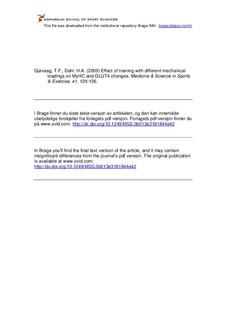| dc.contributor.author | Gjøvaag, Terje F. | |
| dc.contributor.author | Dahl, Hans A. | |
| dc.date.accessioned | 2010-10-15T08:42:15Z | |
| dc.date.available | 2010-10-15T08:42:15Z | |
| dc.date.issued | 2009-01 | |
| dc.identifier | Seksjon for fysisk prestasjonsevne / Department of Physical Performance | |
| dc.identifier.citation | Medicine & Science in Sports & Exercise. 2009, 41(1), 129-136 | en_US |
| dc.identifier.issn | 0195-9131 | |
| dc.identifier.uri | http://hdl.handle.net/11250/170757 | |
| dc.description | I Brage finner du siste tekst-versjon av artikkelen, og den kan inneholde ubetydelige forskjeller fra forlagets pdf-versjon. Forlagets pdf-versjon finner du på www.ovid.com: http://dx.doi.org/10.1249/MSS.0b013e3181844e42 / In Brage you'll find the final text version of the article, and it may contain insignificant differences from the journal's pdf version. The original publication is available at www.ovid.com: http://dx.doi.org/10.1249/MSS.0b013e3181844e42 | en_US |
| dc.description.abstract | Purpose: There is an inverse relationship between insulin sensitivity and percentage of myosin heavy chain IIx (MyHC IIx) isoform in sedentary, obese, and type 2 diabetic humans. How different exercise conditions may reduce the proportion of MyHC IIx and in parallel elevate glucose transporter 4 (GLUT4) content is interesting in a therapeutic setting. This study investigates the nature of exercise signals regulating MyHC gene switching and whether it is accompanied by GLUT4 changes.
Methods: Thirty-two subjects performed high loading (60% of 1 repetition maximum [RM]) or low loading (30% of 1 RM) elbow extensions in a training apparatus and exercised three times per week for either 5 wk (low volume) or 8 wk (high volume). MyHC and GLUT4 contents in the musculus triceps brachii were measured by Western blotting pre- and posttraining and after 8 wk of detraining.
Results: All training regimes resulted in MyHC IIx changes of similar magnitude, and differences in training volume had no effect on the outcome. The reduction in MyHC IIx content after high loading, high volume was similar to low loading, matching volume of training. Thus, there was no effect of training load on MyHC changes. GLUT4 increased more after high than low loading (P < 0.0.1). In addition, the larger increases in the GLUT4 were associated with the larger reductions in MyHC IIx content (r = -0.56, P < 0.01). Detraining returned GLUT4 to baseline, but MyHC IIx content was still higher than baseline (P < 0.01).
Conclusion: Magnitude of loading is not important for suppression of MyHC IIx but for increases in GLUT4 content. The GLUT4 content responded, however, more rapidly to detraining than the MyHC IIx and IIa isoforms. | en_US |
| dc.language.iso | eng | en_US |
| dc.publisher | American College of Sports Medicine | en_US |
| dc.subject | exercise | en_US |
| dc.subject | muscles | en_US |
| dc.subject | continuous | en_US |
| dc.subject | intermittent | en_US |
| dc.subject | myosin heavy chains | en_US |
| dc.subject | glucose transporter 4 | en_US |
| dc.title | Effect of training with different mechanical loadings on MyHC and GLUT4 changes | en_US |
| dc.type | Journal article | en_US |
| dc.type | Peer reviewed | en_US |
| dc.subject.nsi | VDP::Social science: 200::Social science in sports: 330::Other subjects within physical education: 339 | en_US |
| dc.source.pagenumber | 129-136 | en_US |
